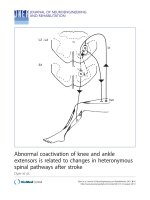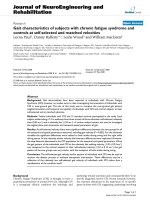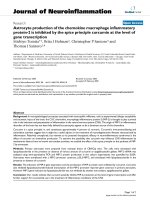Báo cáo hóa học: " Improved characteristics of near-band-edge and deep-level emissions from ZnO nanorod arrays by atomic-layer-deposited Al2O3 and ZnO shell layers" potx
Bạn đang xem bản rút gọn của tài liệu. Xem và tải ngay bản đầy đủ của tài liệu tại đây (1.32 MB, 9 trang )
NANO EXPRESS Open Access
Improved characteristics of near-band-edge and
deep-level emissions from ZnO nanorod arrays by
atomic-layer-deposited Al
2
O
3
and ZnO shell layers
Wen-Cheng Sun
1,2
, Yu-Cheng Yeh
1,2
, Chung-Ting Ko
1
, Jr-Hau He
2*
and Miin-Jang Chen
1*
Abstract
We report on the characteristics of near-band-edge (NBE) emission and deep-level band from ZnO/Al
2
O
3
and ZnO/
ZnO core-shell nanorod arrays (NRAs). Vertically aligned ZnO NRAs were synthesized by an aqueous chemical
method, and the Al
2
O
3
and ZnO shell layers were prepared by the highly conformal atomic layer deposition
technique. Photoluminescence measurements revealed that the deep-level band was suppressed and the NBE
emission was significantly enhanced afte r the deposition of Al
2
O
3
and ZnO shells, which are attributed to the
decrease in oxygen interstitials at the surface and the reduction in surface band bending of ZnO core, respectively.
The shift of deep-level emissions from the ZnO/ZnO core-shell NRAs was observed for the first time. Owing to the
presence of the ZnO shell layer, the yellow band associated with the oxygen interstitials inside the ZnO core
would be prevailed over by the green luminescence, which originates from the recombination of the electrons in
the conduction band with the holes trapped by the oxygen vacancies in the ZnO shell.
PACS 68.65.Ac; 71.35 y; 78.45.+h; 78.55 m; 78.55.Et; 78.67.Hc; 81.16.Be; 85.60.Jb.
Introduction
Because of large surface-to-volume ratio and spatial con-
finement of carrie rs, researches on one-dimensional (1D)
nanostructures have attracted g reat interest [1-3], and
remarkable progress has been achieved in various electro-
nic, photonic, and sensing devices [3-7]. Novel synthetic
approaches to the fabrication of high-quality semiconduc-
tor nanotubes have been reviewed by Yan et al. [8]. Zinc
oxide (ZnO) has been regarded as one of the most promis-
ing materials for 1D nanostructures due to its distin-
guished c haracteristi cs such as dir ect an d wide band gap
(approximately 3.37 eV), large excitonic binding energy
(up to 60 meV), and high piezoelectricity [9-11]. The
synthesis of well-aligned ZnO nanorod arrays (NRAs) is
crucially important for the practical applications such as
field emitters [12], nanogenerators [13], solar cells [14],
and nanolasers [15]. One of the popular techniques for
fabricating ZnO NRAs is to use Au as catalyst on a lattice-
matched substrate [16]. Since the optical properties of
ZnO NRAs are strongly dependent on surface conditions
[17-20] and natural defect states [21-24], a large variety of
surface modifications on ZnO NRAs have been carried
out by depositing a shell layer. For instance, the enhance-
ment of photoluminescence (PL) has been observed in
ZnO/Er
2
O
3
and ZnO/MgZnO core-shell NRAs [25,26].
The enhanced surface-excitonic emission together with
the suppression in deep-level emission has also been
reported in ZnO/amorphous-Al
2
O
3
core-shell nanowires
[27]. Apart f rom the enhancement of light emission,
strong photoconductivity [28], photocatalytic activity [29],
and quantum confinement [30] have been observed in var-
ious 1D ZnO nanostructures.
In this paper, vertically aligned ZnO NRAs were synthe-
sized using an aqueous chemical method, which is benefi-
cial for low reaction temperature, low cost, catalyst-free
synthesis, and large-scale production. The growth of ZnO
NRAs was assisted by a ZnO seed layer prepared by
atomic layer deposition (ALD). The self-limiting and
layer-by-layer grow th of ALD contribute to many advan-
tages such as easy and accurate thickness control, confor-
mal step coverage, hi gh uniformity over a large area , low
defect density, good reproducibility, and low deposition
* Correspondence: ;
1
Department of Materials Science and Engineering, National Taiwan
University, Taipei 10617, Taiwan
2
Graduate Institute of Photonics and Optoelectronics, National Taiwan
University, Taipei 10617, Taiwan
Full list of author information is available at the end of the article
Sun et al. Nanoscale Research Letters 2011, 6:556
/>© 2011 Sun et al; licensee Springer. This is an Open Access article distributed under the terms of the Creative Commons Attribution
License ( which permits unrestricted use, distrib ution, and reproduction in any medium,
provided the original work is properly cited.
temperature. Therefore, highly conformal Al
2
O
3
and
ZnO shell layers could be deposited upon the surface of
ZnO nanorods by ALD to form the ZnO/Al
2
O
3
and ZnO/
ZnO core-shell NRAs in this study. PL measurements
were conducted to investigate the optical characteristics of
ZnO/Al
2
O
3
and ZnO/ZnO core-shell NRAs. The near-
band-edge (NBE) emission was significantly enhanced, and
the deep-level band was suppressed by the Al
2
O
3
and ZnO
shells due to the flat-band effect and the reduction in the
surface defect density. In addition, the shift of deep-level
emissions from t he yellow band to the green band in
ZnO/ZnO core-shell structure was reported. The mechan-
isms of flat-band effect and the shift of deep-level emis-
sions were elucidated in detail.
Experimental details
The ZnO NRAs were synthesized on (100) Si wafers by
aqueous chemical growth. Before the synthesis, a 50-
nm-t hick ZnO seed layer was deposited on the wafer at
a temperature of 180°C by ALD. Diethylzinc and H
2
O
vapors were used as the precursors for zinc and oxygen,
respectively. After the ALD deposition, the seed layer
was treated by rapid thermal annealing at 950°C for 5
min in nitrogen atmosphere to improve its crystal qual-
ity. Afterwards, the ZnO NRAs were grown in 320 ml
aqueous solution, containing 10 mM zinc nitrate hexa-
hydrate and 5 ml ammonia solution, a t 95°C for 2 h.
More details of ZnO NRA synthesis have been
described elsewhere [31,32]. F inally, Al
2
O
3
and ZnO
shell layers were prepared by the ALD on the as-grown
ZnO NRAs to fabricate ZnO/Al
2
O
3
and ZnO/ZnO
core-shell NRAs. The precursors for Al
2
O
3
deposition
were trimethylaluminum and H
2
O vapors, and the
deposition temperature was 180°C. The Al
2
O
3
shell
layers were 2, 5, and 10 nm in thickness. The ALD con-
dition of ZnO shell layers was the same as that of the
ZnO seed layer. The thicknesses of ZnO shell layers
were 5, 10, and 15 nm, respectively. The details of ZnO
and Al
2
O
3
ALD parameters can be found in our pre-
vious studies [33-35].
The structural characterization of ZnO NRAs was
examined by Germini LEO 1530 field emission scanning
electron microscopy (SEM) (Carl Zeiss Microscopy,
Carl-Zeiss-Straße 56, 73447 Oberkochen, Germany) and
FEI Tecnai G2 T20 transmission electron microscopy
(TEM) (FEI Company, 5350 NE Dawson Creek Drive,
Hillsboro, Oregon 97124 USA). X-ray diffraction (XRD)
measurement was used to characterize t he crystallinity
and crystal orientation of ZnO NRAs. PL spectroscopy
was measured in a standard backscattering configuration
where the light emission from top surface of the ZnO
NRAs was collected, using acontinuous-waveHe-Cd
laser ( l = 325 nm) as the excitation source.
Results and discussion
Top-viewed and cross-sectional SEM images of as-
grown ZnO NRAs are shown in Figure 1a,b, respec-
tively. The diameter of ZnO nanorods is in the range of
90 to 100 nm, and the length is about 1 μm. The sub-
strate-bound NRAs were mechanically scraped, soni-
cated in ethanol, and deposited on carbon-coated
copper grids for TEM characterization. Figure 1c,d
shows low-magnification TEM images of ZnO/Al
2
O
3
and ZnO/ZnO core-shell nanorods, indicating the uni-
formity in both of the core and shell layers. It can be
seen that about 5 nm Al
2
O
3
and 10 nm ZnO shell layers
were deposited upon the surface of ZnO nano rods,
demonstrating high conformality of the ALD technique.
XRD pattern of as-grown ZnO NRAs is shown in Figure
1e, and the only dominant peak corresponding to (0002)
plane was observed in the spectrum, revealing that ZnO
nanorods are hi ghly c-axis orientated. Moreover, it was
noted that ZnO NRAs cannot be synthesized on (100)
Si wafers without the ZnO seed layer.
Figure 2a shows the room-temperature PL spectra of
as-grown ZnO NRAs and those coated with the Al
2
O
3
shell layers. Both the NBE emission (l ≈ 380 nm) and
deep-level band associated with the oxygen interstitials
(O
i
)(l ≈ 550 nm, yellow band) [22] were observed in
the as-grown ZnO NRAs and ZnO/Al
2
O
3
core-shell
NRAs. As compared with as-grown ZnO NRAs, the
NBE emission was significantly enhanced and the deep-
level band was suppressed for the samples coated with
Al
2
O
3
shell layers. The intensity of NBE emission grows
along with the increase of the Al
2
O
3
shell-layer thick-
ness. The deep-level band also increases slightly with
the thickness of the Al
2
O
3
shell layer. The PL spectra
normalized to the peak intensity of each NBE emission
are shown in Figure 2b. It can be seen that the ratio of
the deep-level band to the NBE emission of the samples
coated with Al
2
O
3
shell layers is much smaller than that
of as-grown ZnO NRAs. It may be also noted that the
ratio of deep-level band to the NBE emissio n is almost
identical for the ZnO/Al
2
O
3
core-shell NRAs with dif-
ferent shell-layer thickness, suggesting that the same
mechanism governs the increase of the NBE and deep-
level emissions with the Al
2
O
3
shell-layer thickness.
As compared with the deep-level band of as-grown
ZnO NRAs, the considerable suppression of the deep-
level luminescence by the deposition of Al
2
O
3
shell
layers, as shown in Figure 2a,b, can be ascribed to the
decrease in the density of oxygen interstitials at the sur-
face of ZnO core [36]. The residual deep-level emission
from the ZnO/Al
2
O
3
core-shell NRAs may mainly origi-
nate from the oxygen interstitials inside the ZnO core.
On the other hand, the remarkable enhancement of the
ZnO NBE emission by de positing Al
2
O
3
shell layers can
Sun et al. Nanoscale Research Letters 2011, 6:556
/>Page 2 of 9
be attributed to the flat-band effect [27,37]. Negatively
charged oxygen ions may adsorb on the surface of as-
grown ZnO nanorods, resulting in a d epletion region
near the surface [38]. Weber et al. have reported that
the width o f depletion region is about 20 nm [39],
which is smaller than the diameter of the ZnO nanorods
(approximately 100 nm) prepared in this study. This
depletion region can be regarded as an upward band
bending toward the surface as presented in the band
diagram shown in Figure 3a. When the ZnO NRA s are
irradiated by the pumping laser beam, the photo-gener-
ated holes are inclined to accumulate near the surface,
and the photo-generated electrons tend to reside inside
the core. As a result, the wavefunctions of electrons and
holes are separated from each other, lowering the prob-
ability of radiative recombination to yield NBE emission.
However, as plotted schematically in Figure 3b, the
Al
2
O
3
shell layer would eliminate the oxygen ions
adsorbed on the ZnO surface and hence reduce the
band bending near the interface [27]. Therefore, the
Figure 1 SEMimages,TEMimages,andXRDpattern.(a) Top-viewed and (b) cross-sectiona l SEM images of as-grown ZnO NRAs, (c) TEM
image of the ZnO core with approximately 5 nm Al
2
O
3
shell, (d) TEM image of the ZnO core with approximately 10 nm ZnO shell, and (e) XRD
pattern of as-grown ZnO NRAs.
Sun et al. Nanoscale Research Letters 2011, 6:556
/>Page 3 of 9
overlap between the wavefunctions of electrons and
holes in the ZnO core is increased, leading to the
enhancement of NBE emission. The increase of the
Al
2
O
3
shell-layer thickness from 2 to 10 nm may further
lower the band bending near the interface and thus
enhance the wavefunction overlap, result ing in the
increase in NBE emission with the thickness of the
Al
2
O
3
shell layer. The same argument also holds for
Figure 2 PL spectra.(a) Room-temperature PL spectra of as-grown ZnO NRAs and those coated with Al
2
O
3
shell layers of different thicknesses.
(b) Normalized PL spectra of (a). The PL spectra were normalized to the peak intensity of the NBE emission.
Sun et al. Nanoscale Research Letters 2011, 6:556
/>Page 4 of 9
the carrier recombination through the deep-level states
inside the ZnO core. As illustrated in Figure 3a,b, the
flat-band effect may also enhance the deep-level emis-
sion around l ≈ 550 nm originating from the oxygen
interstitials inside the ZnO core due to the increase of
the wavefunction overlap. Accordingly, as shown in Fi g-
ure 2b, the normalized PL spectra present almost the
same ratio of the deep-level band to the NBE emission
A
B
Figure 3 Band diagrams. Schematic band diagrams of (a) as-grown ZnO NRAs and (b) ZnO/Al
2
O
3
core-shell NRAs.
Sun et al. Nanoscale Research Letters 2011, 6:556
/>Page 5 of 9
Figure 4 PL spectra. Room-temperature PL spectra of as-grown ZnO NRAs and those coated with ZnO shell layers of different thicknesses.
Figure 5 PL spectrum. Room-temperature PL spectrum of the ZnO seed layer grown by ALD.
Sun et al. Nanoscale Research Letters 2011, 6:556
/>Page 6 of 9
for the NRAs with different Al
2
O
3
shell- layer thickness,
indicating that the increase of the Al
2
O
3
shell-layer
thickness enhances both the NBE and deep-level emis-
sions due to the flat-band effect.
To further investigate the effect of surface band bend-
ing in ZnO nanorods, we conducted the PL measurement
on ZnO/ZnO core-shell NRAs with different thicknesses
of ZnO shell layers. Since the absorption coefficient of
Figure 6 Band diagrams. Schematic band diagram of ZnO/ZnO core-shell structures with ZnO shell layers of different thicknesses.
Sun et al. Nanoscale Research Letters 2011, 6:556
/>Page 7 of 9
ZnO at l = 325 nm is about 1.5 × 10
5
cm
-1
[40] and the
estimated penetration depth is approximately 67 nm,
both ZnO cores and ZnO shells could be excited by the
He-Cd laser during the PL measurement. Figure 4 shows
the PL spectra of the as-grown ZnO NRAs and ZnO/
ZnO core-shell NRAs at room temperature. As compared
with as-grown ZnO NRAs, the NBE emission was
enhanced and the deep-l evel band around 55 0 nm was
suppressed after a 5-nm-thick ZnO shell layer was depos-
ited. This can be realized that the ZnO shell layer could
give rise to the increase of the flat-band region in the
ZnO core and the reduction in the density of oxygen
interstitials at the surface of ZnO core. Similar to the
ZnO/Al
2
O
3
core-shell NRAs, the residual deep-level
band around l ≈ 550 nm of the NRAs coated with a 5-
nm-thick ZnO shell layer can be attributed to light emis-
sion from the oxygen interstitials inside the ZnO core.
Figure 4 also presents the remarkable shift of the
defect-related luminescence, from the yellow band
(approximately 550 nm) to the green band (approxi-
mately 490 nm), as the thickness of the ZnO shell layer
is greater than 10 nm. This green ban d can be also
found in the PL spectrum of the ZnO seed layer grown
by ALD, as shown in Figure 5, suggesting that the green
band may originate from the ALD ZnO shell layer. It
has been reported that the green band arises from the
recombination of the electrons in the conduction band
and the holes trapped by the
V
+
0
center (one electron at
the site of oxygen vacancy) [27,41]. As shown schemati-
cally in Figure 6a, the photo-generated holes are accu-
mulated near the surface of ZnO nanorods due to the
surface band bending. As a 5-nm-thick ZnO shell layer
was deposited by ALD, the
V
+
0
centers in the ZnO shell
layer trap the photo-generated holes and then convert
to
V
++
0
, as illustrated in Figure 6b. However, the band
bending depletes the electrons near the surface so as t o
suppress the recombination of the electrons and the
V
++
0
centers. As a result, the green band associated with
V
++
0
did not appear; instead, the yellow band from the
oxygen interstitials inside the ZnO core was observed in
the PL spectrum. F igure 6c shows that the extension of
flat-band region in the ZnO core can reach the ZnO/
ZnO core-shell interface as the ZnO shell layer is thick
enough. Therefore, the
V
++
0
centers can recombine with
the electrons in the conduction band to yield the green
luminescence. As a result, the green band dominates
over the yellow band as the ZnO shell-layer thickness is
greater than 10 nm, as shown in the PL spectra in
Figure 4.
Conclusion
In summary, the ZnO/Al
2
O
3
and ZnO/ZnO core-shell
NRAs have been prepared using the aqueous chemical
synthesis and the conformal ALD technique. The deep-
level emission around l ≈ 550 nm from the oxygen
interstitials at the surface of ZnO cores was suppressed
by the A l
2
O
3
and ZnO shell layers. The shell layers also
reduce the surface band bending, leading to the increase
in overlap of the wavefunctions of electrons and holes
in the ZnO core. Therefore, the NBE em ission at l ≈
380 nm and the deep-level band around l ≈ 550 nm
from the oxygen interstitials inside the core were
enhanced by the shell layers. Furthermore, the shift of
defect-related emissions from the ZnO/ZnO core-shell
NRAs was observed due to the competition between
light emissions from the oxygen interstitials inside the
ZnOcoreandtheoxygenvacanciesintheZnOshell.
As the thickness of the ZnO shell layer increased, the
green luminescence (l ≈ 490 nm) originating from the
oxygen vacancies in the shell dominated over the yellow
band (l ≈ 550 nm) associated with the oxygen intersti-
tials inside the ZnO core due to the flat-band effect.
The results indicate that the shell layers prepared by
ALD have significant influence both on the NBE and
defect-related emissions of the ZnO NRAs.
Acknowledgements
This work was financially supported by the National Science Council in
Taiwan under contract number NSC98-2112-M-002-018-MY2 and NSC100-
3113-E002-011.
Author details
1
Department of Materials Science and Engineering, National Taiwan
University, Taipei 10617, Taiwan
2
Graduate Institute of Photonics and
Optoelectronics, National Taiwan University, Taipei 10617, Taiwan
Authors’ contributions
All the authors contributed to the writing of the manuscript. WCS and YCY
carried out the experiments under the instruction of MJC. CTK performed
the TEM measurement. All authors read and approved the final manuscript.
Competing interests
The authors declare that they have no competing interests.
Received: 2 June 2011 Accepted: 17 October 2011
Published: 17 October 2011
References
1. Sirbuly DJ, Law M, Yan H, Yang P: Semiconductor nanowires for
subwavelength photonics integration. J Phys Chem B 2005,
109:15190-15213.
2. Fang X, Gautamy UK, Bando Y, Golberg D: One-dimensional ZnS-based
hetero-, core/shell and hierarchical nanostructures. J Mater Sci Technol
2008, 24:520-528.
3. Appell D: Nanotechnology: wired for success. Nature 2002, 419:553-555.
4. Duan XF, Huang Y, Cui Y, Wang JF, Lieber CM: Indium phosphide
nanowires as building blocks for nanoscale electronic and
optoelectronic devices. Nature 2001, 409:66-69.
5. He JH, Ho CH: The study of electrical characteristics of heterojunction
based on ZnO nanowires using ultrahigh-vacuum conducting atomic
force microscopy. Appl Phys Lett 2007, 91:233105.
6. He JH, Hsin CL, Liu J, Chen LJ, Wang ZL: Piezoelectric gated diode of a
single ZnO nanowire. Adv Mater 2007, 19:781-784.
7. He JH, Lin YH, McConney ME, Tsukruk VV, Wang ZL, Bao G: Enhancing UV
photoconductivity of ZnO nanobelt by polyacrylonitrile functionalization.
J Appl Phys 2007, 102:084303.
Sun et al. Nanoscale Research Letters 2011, 6:556
/>Page 8 of 9
8. Yan C, Liu J, Liu F, Wu J, Gao K, Xue D: Tube formation in nanoscale
materials. Nanoscale Res Lett 2008, 3:473-480.
9. Ozgur U, Alivov YI, Liu C, Teke A, Reshchikov MA, Dogan S, Avrutin V,
Cho SJ, Morkocd H: A comprehensive review of ZnO materials and
devices. J Appl Phys 2005, 98:041301.
10. Jagadish C, Pearton SJ: Zinc Oxide Bulk, Thin Films and Nanostructures:
Processing, Properties and Application Oxford: Elsevier; 2006.
11. Wu J, Xue D: Progress of science and technology of ZnO as advanced
material. Science of Advanced Materials 2011, 3 :127-149.
12. Huo KF, Hu YM, Fu JJ, Wang XB, Chu PK, Hu Z, Chen Y: Direct and large-
area growth of one-dimensional ZnO nanostructures from and on a
brass substrate. J Phys Chem C 2007, 111:5876-5881.
13. Wang XD, Song JH, Liu J, Wang ZL: Direct-current nanogenerator driven
by ultrasonic waves. Science 2007, 316:102-105.
14. Law M, Greene LE, Johnson JC, Saykally R, Yang PD: Nanowire dye-
sensitized solar cells. Nat Mater 2005, 4:455-459.
15. Huang MH, Mao S, Feick H, Yan HQ, Wu YY, Kind H, Weber E, Russo R,
Yang PD: Room-temperature ultraviolet nanowire nanolasers. Science
2001, 292:1897-1899.
16. He JH, Hsu JH, Wang CW, Lin HN, Chen LJ, Wang ZL: Pattern and feature
designed growth of ZnO nanowire arrays for vertical devices. J Phys
Chem B 2006, 110:50-53.
17. Travnikov VV, Freiberg A, Savikhin SF: Surface excitons in ZnO crystals. J
Lumin 1990, 47:107-112.
18. Savikhin S, Freiberg A: Origin of “universal” ultraviolet luminescence from
the surfaces of solids at low temperatures. J Lumin 1993, 55:1-3.
19. Wischmeier L, Voss T, Borner S, Schade W: Comparison of the optical
properties of as-grown ensembles and single ZnO. Appl Phys A 2006,
84:111-116.
20. Shimpi P, Gao PX, Goberman D, Ding Y: Low temperature synthesis and
characterization of MgO/ZnO composite nanowire arrays.
Nanotechnology 2009, 20:125608.
21. Vanheusden K, Warren WL, Seager CH, Tallant DR, Voigt JA, Gnade BE:
Mechanisms behind green photoluminescence in ZnO phosphor
powders. J Appl Phys 1996, 79:7983-7990.
22. Li D, Leung YH, Djurisic AB, Liu ZT, Xie MH, Shi SL, Xu SJ, Chan WK:
Different origins of visible luminescence in ZnO nanostructures
fabricated by the chemical and evaporation methods. Appl Phys Lett
2004, 85:1601-1603.
23. Hsu NE, Hung WK, Chen YF: Origin of defect emission identified by
polarized luminescence from aligned ZnO nanorods. J Appl Phys 2004,
96:4671-4673.
24. Kärber E, Raadik T, Dedova T, Krustok J, Mere A, Mikli V, Krunks M:
Photoluminescence of spray pyrolysis deposited ZnO nanorods.
Nanoscale Res Lett 2011, 6:359.
25. Park WI, Yoo J, Kim DW, Yi GC: Fabrication and photoluminescent
properties of heteroepitaxial ZnO/Zn
0.8
Mg
0.2
O coaxial nanorod
heterostructures. J Phys Chem B 2006, 110:1516-1519.
26. Li SZ, Gan CL, Cai H, Yuan CL, Guo J, Lee PS, Ma J: Enhanced
photoluminescence of ZnO/Er
2
O
3
core-shell structure nanorods
synthesized by pulsed laser deposition. Appl Phys Lett 2007, 90:263106.
27. Richters JP, Voss T, Skim D, Scholz R, Zacharias M: Enhanced surface-
excitonic emission in ZnO/Al
2
O
3
core-shell nanowires. Nanotechnology
2008, 19:305202.
28. Soci C, Zhang A, Xiang B, Dayeh SA, Aplin DPR, Park J, Bao XY, Lo YH,
Wang D: ZnO nanowire UV photodetector with high internal gain. Nano
Lett 2007, 7:1003-1009.
29. Lu HB, Li H, Liao L, Tian Y, Shuai M, Li JC, Hu MF, Fu Q, Zhu BP: Low-
temperature synthesis and photocatalytic properties of ZnO nanotubes
by thermal oxidation of Zn nanowires. Nanotechnology 2008, 19:045605.
30. Yin M, Gu Y, Kuskovsky IL, Andelman T, Zhu Y, Neumark GF, O’Brien S: Zin
oxide quantum rods. J Am Chem Soc 2004, 126:6206-6207.
31. Yang WC, Wang CW, He JH, Chang YC, Wang JC, Chen LJ, Chen HY, Gwo S:
Facile synthesis of large scale Er-doped ZnO flower-like structures with
enhanced 1.54 μm infrared emission. Phys Status Solidi A 2008,
205:1190-1195.
32. Greene LE, Yuhas BD, Law M, Zitoun D, Yang PD: Solution-grown zinc
oxide nanowires. Inorg Chem 2006, 45:7535-7543.
33. Chen HC, Chen MJ, Liu TC, Yang JR, Shiojiri M: Structure and stimulated
emission of a high-quality zinc oxide epilayer grown by atomic layer
deposition on the sapphire substrate. Thin Solid Films 2010, 519:536-540.
34. Shih YT, Wu MK, Li WC, Kuan H, Yang JR, Shiojiri M, Chen MJ: Amplified
spontaneous emission from ZnO in n -ZnO/ZnO nanodots-SiO
2
composite/p-AlGaN heterojunction light-emitting diodes. Nanotechnology
2009, 20:165201.
35. Chen MJ, Shih YT, Wu MK, Tsai FY: Enhancement in the efficiency of light
emission from silicon by a thin Al
2
O
3
surface-passivating layer grown by
atomic layer deposition at low temperature. J Appl Phys 2007, 101:033130.
36. Shalish I, Temkin H, Narayanamurti V: Size-dependent surface
luminescence in ZnO nanowires. Phys Rev B 2004, 69:245401.
37. Chen CY, Lin CA, Chen MJ, Lin GR, He JH: ZnO/Al
2
O
3
core-shell nanorod
arrays: growth, structural characterization, and luminescent properties.
Nanotechnology 2009, 20:185605.
38. Vanheusden K, Seager CH, Warren WL, Tallant DR, Voigt JA: Correlation
between photoluminescence and oxygen vacancies in ZnO phosphors.
Appl Phys Lett 1996, 68:403-405.
39. Weber DH, Beyer A, Völkel B, Gölzhäuser A, Schlenker E, Bakin A, Waag A:
Determination of the specific resistance of individual freestanding ZnO
nanowires with the low energy electron point source microscope. Appl
Phys Lett 2007, 91:253126.
40. Muth JF, Kolbas RM, Sharma AK, Oktyabrsky S, Narayan J: Excitonic
structure and absorption coefficient measurements of ZnO single crystal
epitaxial films deposited by pulsed laser deposition. J Appl Phys 1999,
85:7884-7887.
41. Dijken AV, Meulenkamp EA, Vanmaekelbergh D, Meijerink A: The kinetic of
the radiative and nonradiative processes in nanocrystalline ZnO particles
upon photoexcitation. J Phys Chem B 2000, 104:1715-1723.
doi:10.1186/1556-276X-6-556
Cite this article as: Sun et al.: Improved characteristics of near-band-edge
and deep-level emissions from ZnO nanorod arrays by atomic-layer-
deposited Al
2
O
3
and ZnO shell layers. Nanoscale Research Letters 2011 6:556.
Submit your manuscript to a
journal and benefi t from:
7 Convenient online submission
7 Rigorous peer review
7 Immediate publication on acceptance
7 Open access: articles freely available online
7 High visibility within the fi eld
7 Retaining the copyright to your article
Submit your next manuscript at 7 springeropen.com
Sun et al. Nanoscale Research Letters 2011, 6:556
/>Page 9 of 9









